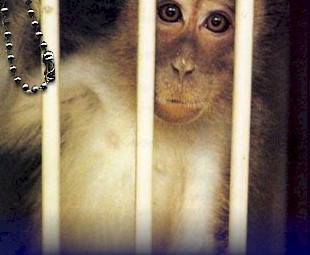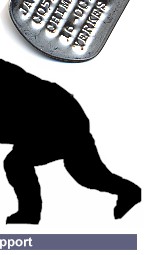#20213 was born in Corral #4 at the
publicly funded Oregon Regional Primate Research Center (ORPRC)
on April 25, 1998. Her mother was #17279, her father is unknown.
She was then, and as of July 9, 2000, remains, assigned to ORPRC"s
breeding program.
On May 20, 1998 she was examined and reported to have a "normal"
appearance.
On June 6, 1999, she was examined and again reported to have a "normal"
appearance. She was anesthetized, injected with an anti-anxiety
agent (zolazepam), treated for parasites, and had a blood sample
taken. Also, on this date, she was immobilized with ketamine and
given a tuberculosis test.
On August 24 she was moved to Corral #3. She was 121 days old, no
mention is made of her mother.
On August 27, 1999 she was removed from breeding Corral #3. She
was immobilized with ketamine and treated for diarrhea and dehydration
(chronic problems at ORPRC). She was treated with electrolytes and
antibiotics. Two days later she was reported to have good hydration.
On September 2, 1999, her medical case was closed. She was returned
to Corral #3 on September 8. She had been out of the corral for
nearly two weeks.
Rhesus macaques live in groups with highly defined complex social
hierarchies based on matrilineages. Researchers often use removal
and reintroductions to groups as experimental stressors. Reestablishment
of one"s social position, or the establishment of a new social
position is a frequent cause of aggression and injury. This is a
fundamental fact of rhesus behavior.
On October 19, 2000, #20213 was once again removed from Corral #3
due to lacerations and punctures to her left hand. She was immobilized
with ketamine, and had the wounds cleaned and sutured. She was given
injections of a broad-spectrum antibiotic for five days.
On October 25, she was returned to Corral #3.
On November 12, 2000, #20213 was again removed from Corral #3. This
time she had a penetrating wound in her left elbow. Her medical
records note that she was the "victim of physical trauma."
She was again treated with antibiotics and had her wounds cleaned
and sutured. On December 1, after being away for almost three weeks,
#20213 was returned to Corral #3.
On January 4, she was once again removed from Corral #3 with penetrating
wounds to her "right upper extremity." Once again, she
was treated with antibiotics and had her wounds cleaned and sutured.
On January 25, she was, once again, returned to Corral #3.
On June 5, she was removed again for unspecified reasons and then
returned to the Corral on June 9, 2000, the last dated entry in
her records. She was two years and 47 days old.
Between August 27, 1999 and January 1, 2000, #20213 had stool specimens
examined for parasites four times. Each examination was positive,
the treatments ineffectual.
In the letter date May
17, 2000, that accompanied her records, the ORPRC public relations
director, James Parker, wrote, "Monkey #20213 lives in an enriched,
1-acre, outdoor environment with 100 other rhesus monkeys. She is
part of a breeding program operated so that monkeys involved in
research are not taken from their natural habitat but are bred specifically
for research. She is in perfect health and is receiving the best
of care from the veterinarians and animal care staff in our program
. . . You can be certain that we share your solicitude for these
monkeys, and all the monkeys in our care."
Home Page | Our Mission | News
What Are Primate Freedom
Tags | Order Tag
Primate Research
Centers | Resources
|












